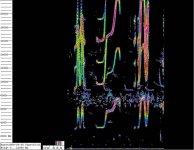Hi,
I'm sure most of you appreciate bird sounds can be many and varied. It isn't until you feed the sound into a spectrum analyser that you realise just how complicated they can be.
I guess a few of you have seen or used a spectrum analyser before, but I'm also guessing quite a few of you haven't. For those of you who haven't - it is basically a way of taking a sound and converting it into a picture (see attachment). To accomplish this is surprisingly simple - all you need is a PC/Laptop, a microphone (optional) and some free software.
Quick set up :
You need to download some free software first. You can download this software here
Now you need to decide how you want to record and analyse the bird sound. You can analyse 'live' sounds using a microphone connected directly to your PC/Laptop. The spectrum analyser will give immediate results. Another option is to record sounds (save them as a wav file) and decode them sometime later using the spectrum analyser. Either way, all you need is some kind of sound, whether it's live or a saved wav file.
Obviously there is a fair amount of experimenting you could do here - it's a vast subject! Luckily for us modern technology has made it relatively simple and it is now possible for almost any of us to 'have a go'.
I realise that this may only appeal to the more 'technically minded' of you. Don't be afraid to give it a go though. Dangle a microphone out of a window, connect it to your PC and start the software - you might be pleased by what you see!
The attached picture is a Lapwing giving three distinct 'cheee-o-wip' sounds with slight variation.
I hope you enjoy - sorry if it doesn't appeal to you!
Rich.
I'm sure most of you appreciate bird sounds can be many and varied. It isn't until you feed the sound into a spectrum analyser that you realise just how complicated they can be.
I guess a few of you have seen or used a spectrum analyser before, but I'm also guessing quite a few of you haven't. For those of you who haven't - it is basically a way of taking a sound and converting it into a picture (see attachment). To accomplish this is surprisingly simple - all you need is a PC/Laptop, a microphone (optional) and some free software.
Quick set up :
You need to download some free software first. You can download this software here
Now you need to decide how you want to record and analyse the bird sound. You can analyse 'live' sounds using a microphone connected directly to your PC/Laptop. The spectrum analyser will give immediate results. Another option is to record sounds (save them as a wav file) and decode them sometime later using the spectrum analyser. Either way, all you need is some kind of sound, whether it's live or a saved wav file.
Obviously there is a fair amount of experimenting you could do here - it's a vast subject! Luckily for us modern technology has made it relatively simple and it is now possible for almost any of us to 'have a go'.
I realise that this may only appeal to the more 'technically minded' of you. Don't be afraid to give it a go though. Dangle a microphone out of a window, connect it to your PC and start the software - you might be pleased by what you see!
The attached picture is a Lapwing giving three distinct 'cheee-o-wip' sounds with slight variation.
I hope you enjoy - sorry if it doesn't appeal to you!
Rich.





